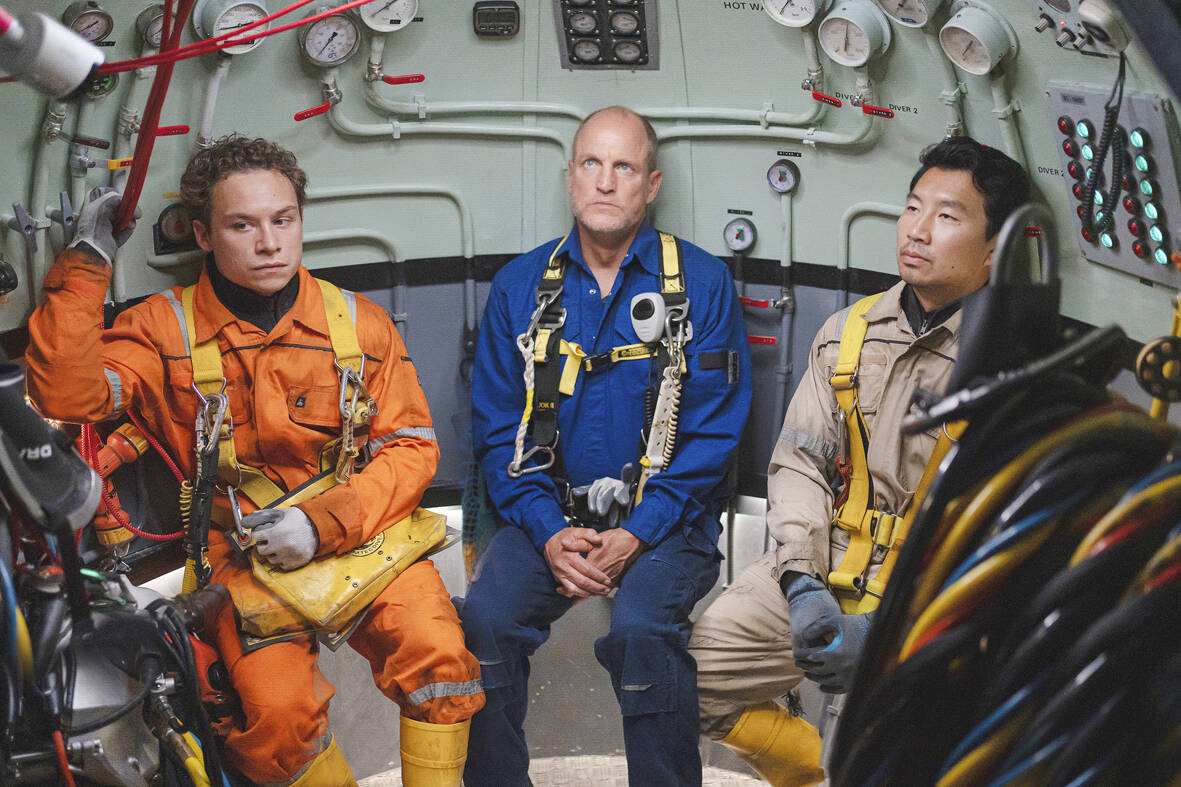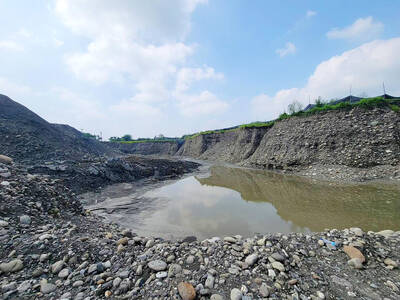A routine deep sea diving mission in the North Sea goes terribly wrong when a young diver is stranded some 300 feet below the surface in the new film Last Breath, currently in theaters. His umbilical cable has severed. The support vessel above is aimlessly drifting away from the site through violent, stormy waters. And the diver has only 10 minutes of oxygen in his backup tank.
As if that wasn’t enough, it’s also a true story.
If merely reading this is giving you heart palpitations already, you can only imagine the white-knuckle experience of watching this all play out on the big screen. It’s 40ish minutes of pure suspense and anxiety as the story shuffles between the man at the bottom of the ocean, Chris Lemons (Finn Cole), his fellow saturation divers (Woody Harrelson as Duncan and Simu Liu as Dave) in the diving bell below the waters who are unable to help and the crew in the support vessel above (including Cliff Cutris and Mark Bonnar) scrambling to get their systems back online and operational as the clock rapidly runs out. Ten minutes has never felt so short — and then it just gets worse as the clock starts counting up, showing Chris’s time without oxygen.

Photo: AP
At one point, Liu’s character Dave, a no-nonsense, all-business diver says matter-of-factly that it’s a body recovery, not a rescue. Deep sea saturation diving is a dangerous business, described at the start of the film as the most dangerous job on earth. Chris tells his fiance, in a short introduction, that it’s no more dangerous than going to space. She replies that it’s funny that he thinks that is comforting.
The real incident happened in September 2012 — Dave, Duncan and Chris were just one team of divers sent to the ocean floor off the coast of Aberdeen, Scotland, to repair an oil pipeline.
The seas were particularly rough that day, with winds up to 35-knots, common for the North Sea but also not what one might call safe. Chris and Dave were in the middle of their work when they heard the urgent calls to abort: The dynamic positioning system in the support vessel above had failed and they were in drift.
Chris scrambled to maneuver out of the pipeline corridors, but his umbilical got caught. For a brief, awful moment he’s the anchor to the ship above, but soon enough the cord snapped, and he was thrown back to the ocean floor in pitch black with no coms, no heat and very little hope for survival. News articles about the incident clock his backup oxygen supply as being closer to five or six minutes — perhaps the movie wanted to give the audience a little buffer.
If this sounds at all familiar, it may be because it was made into a documentary, also called Last Breath and released in 2019. While it was well-received, some true stories are just too gripping to exist solely in that form. It’s not exactly a surprise that a narrative film was made as well. There’s a good track record of recent complimentary adaptations — think Ron Howard’s 13 Lives and The Rescue about the Thai boys soccer team stuck in the cave.
This one was made by Alex Parkinson, the same director who co-directed the doc, and it’s a well-executed narrative interpretation that doesn’t get in its own way with padding. Harrelson gets to be the wise mentor who really doesn’t want to lose someone on his last mission. Liu gets to flex his action muscles (literally and figuratively) in a modest but solid role. And they don’t go out of their way to shoehorn in a villian — this is just a group of people trying their best to save a life.
The only real problem, if one can even call it that, is that it’s so short. The film doesn’t take liberties with stretching out the timeline much at all and after 93 minutes, the whole thing is over. It feels strange to want a movie to be longer, but in the case of Last Breath I was both desperate for it to end, for anxiety reasons, and also wanting more.

Last week the story of the giant illegal crater dug in Kaohsiung’s Meinong District (美濃) emerged into the public consciousness. The site was used for sand and gravel extraction, and then filled with construction waste. Locals referred to it sardonically as the “Meinong Grand Canyon,” according to media reports, because it was 2 hectares in length and 10 meters deep. The land involved included both state-owned and local farm land. Local media said that the site had generated NT$300 million in profits, against fines of a few million and the loss of some excavators. OFFICIAL CORRUPTION? The site had been seized

Next week, candidates will officially register to run for chair of the Chinese Nationalist Party (KMT). By the end of Friday, we will know who has registered for the Oct. 18 election. The number of declared candidates has been fluctuating daily. Some candidates registering may be disqualified, so the final list may be in flux for weeks. The list of likely candidates ranges from deep blue to deeper blue to deepest blue, bordering on red (pro-Chinese Communist Party, CCP). Unless current Chairman Eric Chu (朱立倫) can be convinced to run for re-election, the party looks likely to shift towards more hardline

Sept. 15 to Sept. 21 A Bhutanese princess caught at Taoyuan Airport with 22 rhino horns — worth about NT$31 million today — might have been just another curious front-page story. But the Sept. 17, 1993 incident came at a sensitive moment. Taiwan, dubbed “Die-wan” by the British conservationist group Environmental Investigation Agency (EIA), was under international fire for being a major hub for rhino horn. Just 10 days earlier, US secretary of the interior Bruce Babbitt had recommended sanctions against Taiwan for its “failure to end its participation in rhinoceros horn trade.” Even though Taiwan had restricted imports since 1985 and enacted

Enter the Dragon 13 will bring Taiwan’s first taste of Dirty Boxing Sunday at Taipei Gymnasium, one highlight of a mixed-rules card blending new formats with traditional MMA. The undercard starts at 10:30am, with the main card beginning at 4pm. Tickets are NT$1,200. Dirty Boxing is a US-born ruleset popularized by fighters Mike Perry and Jon Jones as an alternative to boxing. The format has gained traction overseas, with its inaugural championship streamed free to millions on YouTube, Facebook and Instagram. Taiwan’s version allows punches and elbows with clinch striking, but bans kicks, knees and takedowns. The rules are stricter than the